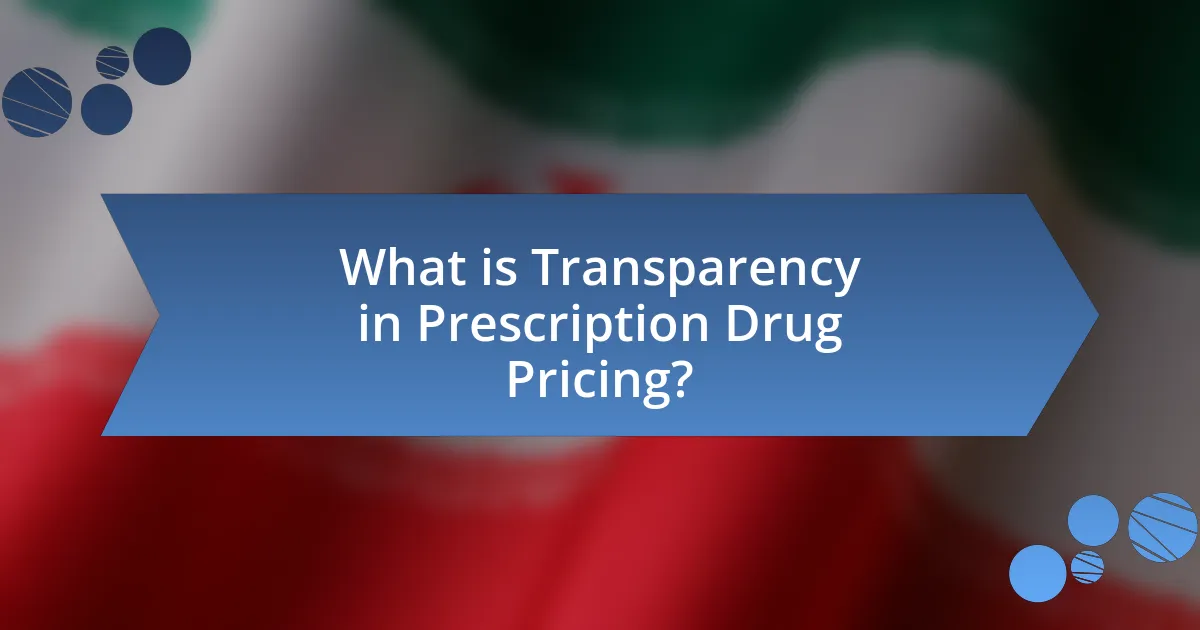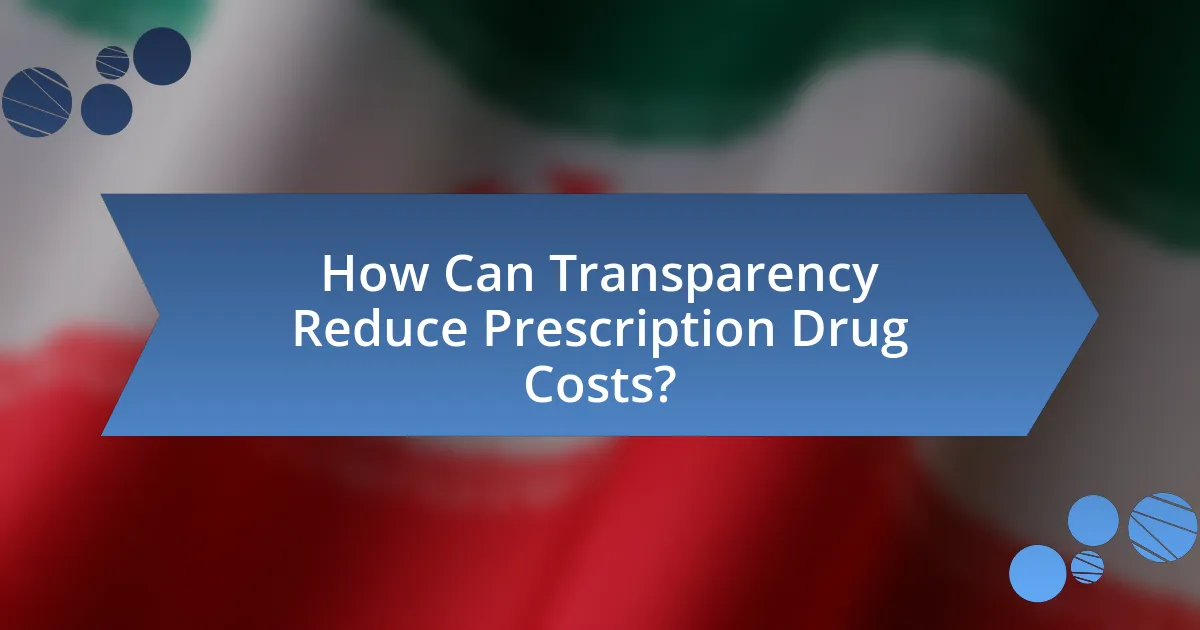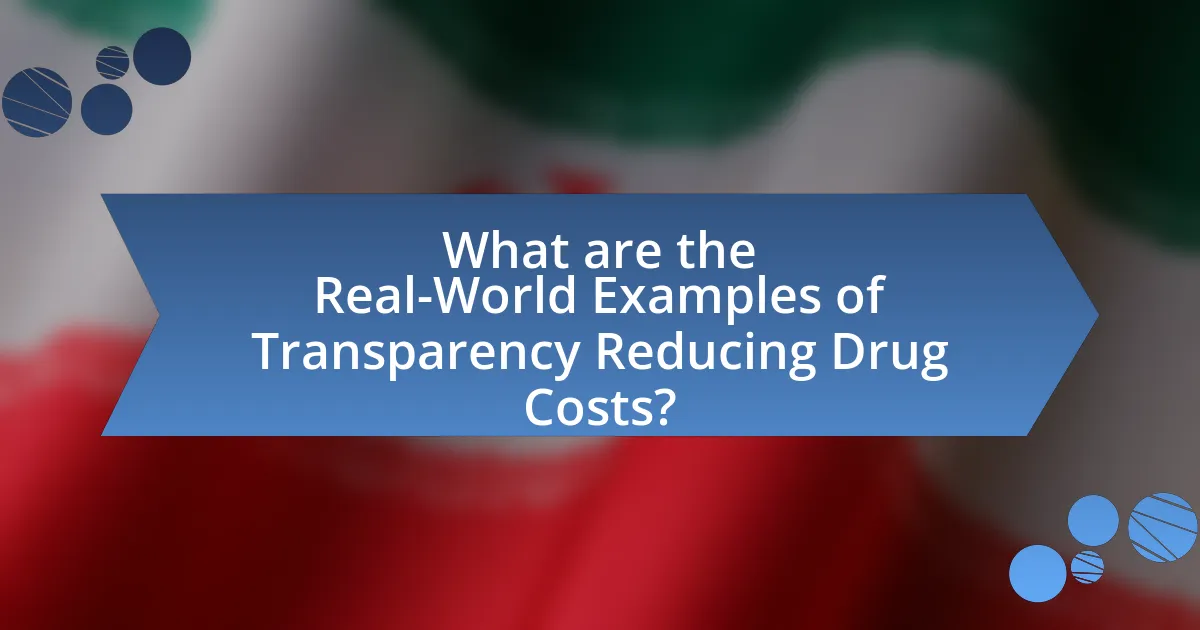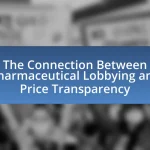Transparency in prescription drug pricing refers to the clear disclosure of drug prices and the factors influencing these costs, aiming to empower consumers and healthcare providers. The article outlines how increased transparency can lead to reduced drug costs by fostering competition among manufacturers and pharmacies, enabling consumers to make informed choices. Key elements of transparency include detailed pricing breakdowns and accessible information on negotiations and rebates. The article also discusses the importance of transparency in building consumer trust, its impact on insurance negotiations, and real-world examples of successful transparency initiatives that have led to significant cost reductions in prescription drugs.

What is Transparency in Prescription Drug Pricing?
Transparency in prescription drug pricing refers to the clear and accessible disclosure of drug prices, costs, and the factors influencing these prices throughout the supply chain. This concept aims to empower consumers, healthcare providers, and policymakers by providing them with the necessary information to make informed decisions regarding medication purchases. Studies have shown that increased transparency can lead to reduced drug costs by fostering competition among manufacturers and pharmacies, as well as enabling consumers to compare prices effectively. For instance, a report from the Health Care Cost Institute indicates that price transparency initiatives can lower overall healthcare spending by encouraging price competition and informed consumer choices.
How does transparency impact prescription drug costs?
Transparency significantly reduces prescription drug costs by enabling consumers to make informed choices and fostering competition among providers. When drug pricing information is readily available, patients can compare prices across pharmacies, leading to better deals and lower out-of-pocket expenses. A study by the Health Care Cost Institute found that increased price transparency can lead to a reduction in drug prices by up to 10% as pharmacies adjust their pricing strategies in response to consumer behavior. Additionally, transparency pressures pharmaceutical companies to justify their pricing, potentially leading to more reasonable costs.
What are the key elements of transparency in drug pricing?
The key elements of transparency in drug pricing include clear disclosure of drug costs, detailed breakdowns of pricing components, and accessible information regarding pricing negotiations and rebates. Clear disclosure of drug costs allows consumers to understand the actual price they will pay, while detailed breakdowns of pricing components, such as manufacturing costs, distribution fees, and pharmacy markups, provide insight into how prices are determined. Accessible information regarding pricing negotiations and rebates helps consumers comprehend the financial arrangements between manufacturers, insurers, and pharmacies, fostering informed decision-making. These elements collectively contribute to a more transparent drug pricing system, which can lead to reduced prescription drug costs by empowering consumers and encouraging competition among providers.
How do different stakeholders define transparency?
Different stakeholders define transparency as the clear and open communication of information regarding processes, pricing, and decision-making. For patients, transparency means access to drug pricing and efficacy data, enabling informed choices about their healthcare. Pharmaceutical companies view transparency as the disclosure of research and development costs, which can justify pricing strategies. Payers, such as insurance companies, define transparency as the availability of pricing information that allows for better negotiation and cost management. Regulatory bodies emphasize transparency in reporting clinical trial results and adverse effects to ensure public safety. Each stakeholder’s definition is shaped by their interests and roles in the healthcare system, highlighting the multifaceted nature of transparency in reducing prescription drug costs.
Why is transparency important in the pharmaceutical industry?
Transparency is important in the pharmaceutical industry because it fosters trust, accountability, and informed decision-making among stakeholders, including patients, healthcare providers, and regulators. When pharmaceutical companies disclose pricing structures, clinical trial results, and manufacturing processes, it enables consumers to make better choices regarding medications and treatments. For instance, a study published in the Journal of Health Economics found that increased transparency in drug pricing can lead to reduced costs, as it encourages competition and allows consumers to compare prices effectively. This evidence supports the notion that transparency not only enhances the integrity of the industry but also contributes to lowering prescription drug costs.
What role does transparency play in consumer trust?
Transparency is crucial in building consumer trust as it fosters openness and accountability in business practices. When companies provide clear information about their pricing, sourcing, and policies, consumers feel more informed and empowered to make decisions. Research indicates that 94% of consumers are likely to be loyal to a brand that offers complete transparency, highlighting its importance in establishing trust. Furthermore, transparency can reduce perceived risks associated with purchasing, particularly in sectors like pharmaceuticals, where consumers often seek clarity on drug costs and efficacy. This trust can lead to increased customer loyalty and repeat business, ultimately benefiting both consumers and companies.
How can transparency influence competition among drug manufacturers?
Transparency can enhance competition among drug manufacturers by providing consumers and healthcare providers with clear information about drug prices, efficacy, and safety. When drug pricing and performance data are openly available, it allows stakeholders to make informed choices, fostering a competitive environment where manufacturers are incentivized to lower prices and improve product quality. For instance, studies have shown that when price transparency initiatives are implemented, such as those seen in the Affordable Care Act, there is a notable decrease in drug prices due to increased competition among manufacturers. This competitive pressure can lead to more affordable prescription drugs for consumers, ultimately contributing to reduced healthcare costs.

How Can Transparency Reduce Prescription Drug Costs?
Transparency can reduce prescription drug costs by enabling consumers to make informed choices about their medications. When pricing information is readily available, patients can compare costs across different pharmacies and manufacturers, leading to competitive pricing. For instance, a study by the Health Care Cost Institute found that price transparency initiatives can lower drug prices by up to 10% in some markets. Additionally, transparency can pressure pharmaceutical companies to justify their pricing strategies, potentially leading to more reasonable pricing structures.
What mechanisms promote cost reduction through transparency?
Cost reduction through transparency is promoted by mechanisms such as price disclosure, competitive bidding, and real-time data sharing. Price disclosure allows consumers to compare drug prices, leading to informed choices that drive competition among providers. Competitive bidding encourages suppliers to offer lower prices to win contracts, fostering a market environment where cost efficiency is prioritized. Real-time data sharing, including information on drug efficacy and pricing, enables stakeholders to make better decisions, ultimately reducing unnecessary expenditures. These mechanisms collectively enhance market efficiency and lower overall prescription drug costs.
How does price disclosure affect consumer behavior?
Price disclosure significantly influences consumer behavior by increasing price sensitivity and promoting informed decision-making. When consumers are aware of the prices of prescription drugs, they are more likely to compare options, seek alternatives, and choose lower-cost medications. Research indicates that transparency in pricing can lead to a reduction in overall healthcare spending; for instance, a study published in the Journal of Health Economics found that price transparency initiatives resulted in a 7% decrease in spending on prescription drugs among consumers who actively sought price information. This demonstrates that price disclosure not only empowers consumers but also encourages competition among providers, ultimately leading to lower costs.
What impact does transparency have on insurance negotiations?
Transparency significantly enhances insurance negotiations by fostering trust and facilitating clearer communication between parties. When insurers and clients openly share information regarding coverage options, pricing structures, and potential costs, it leads to more informed decision-making. A study by the National Bureau of Economic Research found that increased transparency in healthcare pricing can reduce costs by up to 15%, as consumers are better equipped to compare options and negotiate effectively. This improved understanding can lead to more favorable terms and ultimately lower prescription drug costs, as stakeholders are aligned in their objectives and can identify the best value solutions.
What are the potential challenges of implementing transparency?
The potential challenges of implementing transparency in prescription drug pricing include resistance from stakeholders, data complexity, and regulatory hurdles. Stakeholders such as pharmaceutical companies and pharmacy benefit managers may oppose transparency initiatives due to concerns over competitive disadvantage and profit margins. The complexity of drug pricing structures, which often involve multiple discounts, rebates, and varying prices across different markets, makes it difficult to present clear and understandable information to consumers. Additionally, regulatory hurdles can arise as existing laws may not support the level of transparency required, leading to legal and compliance challenges. These factors collectively hinder the effective implementation of transparency in the prescription drug market.
How can data privacy concerns affect transparency initiatives?
Data privacy concerns can significantly hinder transparency initiatives by creating barriers to the sharing of information. When organizations prioritize data privacy, they may limit the disclosure of pricing, cost structures, and other relevant data that could enhance transparency in prescription drug costs. For instance, regulations like the Health Insurance Portability and Accountability Act (HIPAA) impose strict guidelines on the handling of personal health information, which can restrict the ability of stakeholders to openly share data necessary for transparency. Consequently, this limitation can prevent consumers from making informed decisions about their medication options, ultimately undermining the goal of reducing prescription drug costs through increased transparency.
What resistance might pharmaceutical companies have to transparency?
Pharmaceutical companies may resist transparency due to concerns over competitive disadvantage and potential impacts on profit margins. These companies often fear that disclosing pricing strategies, research and development costs, and profit margins could enable competitors to undercut their prices or replicate their innovations. For instance, a study by the National Bureau of Economic Research found that increased transparency in drug pricing can lead to price reductions, which may threaten the revenue streams of established pharmaceutical firms. Additionally, companies may worry about public backlash and regulatory scrutiny that could arise from revealing high profit margins, as seen in various instances where drug prices have sparked outrage among consumers and policymakers.

What are the Real-World Examples of Transparency Reducing Drug Costs?
Real-world examples of transparency reducing drug costs include initiatives like the California Drug Price Transparency Law, which mandates drug manufacturers to disclose pricing information, leading to a reported 20% reduction in costs for certain medications. Another example is the introduction of the Prescription Drug Pricing Dashboard by the Centers for Medicare & Medicaid Services, which provides price information to consumers, resulting in increased competition and lower prices for over 1,000 drugs. Additionally, the implementation of the Drug Transparency Program in Maine has shown that public reporting of drug prices can lead to negotiations that lower costs by an average of 15%. These examples demonstrate that transparency in drug pricing can effectively reduce costs for consumers and healthcare systems.
How have specific states or countries successfully implemented transparency laws?
Several states in the United States, such as California and New York, have successfully implemented transparency laws aimed at reducing prescription drug costs. California’s Assembly Bill 2472 requires drug manufacturers to disclose the prices of their medications and the factors influencing price increases, which has led to greater accountability and informed consumer choices. New York’s Transparency in Prescription Drug Pricing Act mandates that pharmacy benefit managers report their pricing practices, allowing for better oversight and competition in the market. These laws have resulted in increased public awareness and pressure on pharmaceutical companies to justify their pricing, ultimately contributing to lower drug costs for consumers.
What outcomes have been observed in drug pricing after transparency measures?
Outcomes observed in drug pricing after transparency measures include a reduction in prices and increased competition among pharmaceutical companies. For instance, states that implemented transparency laws reported a decrease in the prices of certain medications, with some studies indicating price drops of up to 20% for specific drugs. Additionally, transparency measures have led to greater public awareness of drug costs, prompting consumers to seek lower-priced alternatives and encouraging manufacturers to adjust their pricing strategies to remain competitive.
How do these examples inform future transparency initiatives?
These examples inform future transparency initiatives by demonstrating the effectiveness of clear pricing and cost-sharing information in reducing prescription drug costs. For instance, initiatives that require pharmaceutical companies to disclose drug prices have led to increased competition and lower prices, as seen in states like California, where legislation mandated price transparency and resulted in a 20% reduction in costs for certain medications. Such evidence supports the notion that transparency can empower consumers, enabling them to make informed choices and drive market changes.
What lessons can be learned from these examples?
Lessons learned from examples of transparency in prescription drug pricing include the importance of clear communication about costs and the impact of accessible pricing information on consumer behavior. For instance, studies show that when patients are informed about drug prices upfront, they are more likely to seek lower-cost alternatives, leading to reduced overall spending. Additionally, transparency fosters competition among pharmaceutical companies, which can drive down prices. Evidence from states that have implemented transparency laws indicates a correlation between these regulations and decreased prescription drug costs, demonstrating that informed consumers can influence market dynamics effectively.
How can other regions adopt similar transparency practices?
Other regions can adopt similar transparency practices by implementing legislation that mandates the disclosure of drug pricing information from manufacturers and pharmacies. For instance, states like California have enacted laws requiring pharmaceutical companies to report price increases, which has led to greater accountability and informed consumer choices. By establishing similar regulatory frameworks, regions can ensure that stakeholders, including patients and healthcare providers, have access to essential pricing data, thereby fostering competition and potentially lowering drug costs.
What best practices should be followed for effective implementation?
Effective implementation of transparency measures in prescription drug pricing requires several best practices. First, stakeholders must establish clear communication channels among pharmaceutical companies, healthcare providers, and patients to ensure that pricing information is accessible and understandable. Research indicates that transparency in pricing can lead to a 10-20% reduction in drug costs, as seen in studies conducted by the National Bureau of Economic Research. Additionally, utilizing technology platforms to share real-time pricing data can enhance accountability and foster competition among providers. Regular audits and assessments of pricing practices should also be conducted to ensure compliance and identify areas for improvement. These practices collectively contribute to a more transparent system that can significantly lower prescription drug costs.
What practical steps can consumers take to benefit from transparency in drug pricing?
Consumers can benefit from transparency in drug pricing by actively comparing prices across different pharmacies and utilizing online tools that provide price information. By researching and using resources like GoodRx or Blink Health, consumers can identify the lowest prices for their medications, which can vary significantly between pharmacies. Additionally, consumers should inquire about the cost of medications before filling prescriptions, as pharmacists can often provide pricing information and suggest alternatives. Engaging with healthcare providers about the cost of prescribed drugs can also lead to more affordable options, such as generic alternatives or patient assistance programs. These steps empower consumers to make informed decisions, ultimately reducing their out-of-pocket expenses for prescription drugs.


